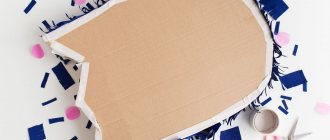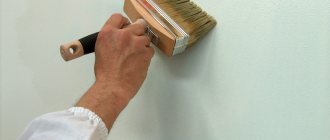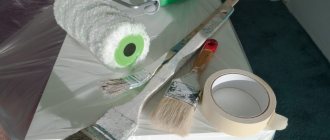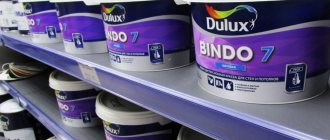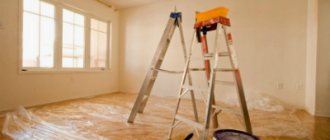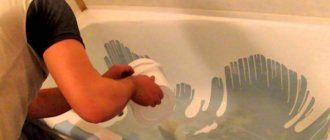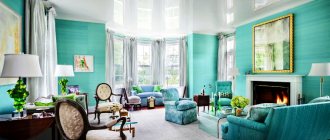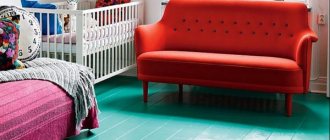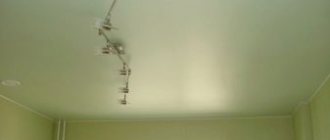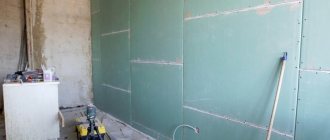Why do you need to paint the ceiling?
Painting ceilings is the least expensive way to decorate the space in a room in terms of finances and effort.
However, this finish also has a number of other advantages:
- durable coating that will not fade or wear off
- finishing that can be replaced in whole or in part in a short period of time
- visual smoothing of uneven surfaces
- quick results with minimal labor costs
- selection of colors and textures for any design solution
Painting the ceiling is an inexpensive but effective way to update the appearance of a room and decorate it.
Advantages of painting over other finishing methods:
- Does not reduce the usable area of the room, unlike suspended ceilings
- Does not require skills or special equipment
- Water resistance and ability to carry out wet cleaning
Useful little things
- Paint consumption is indicated by the manufacturer on the packaging. On average it is 150-250 grams per square meter when applying two layers.
- If you are tinting paint for a room, mix a volume 10 percent higher than calculated . Overspending is always possible, and it is usually unrealistic to achieve the same shade when re-tinting.
When tinting, mix the paint with a small margin.
- If you are offered paint at a price below 30 rubles per liter, most likely its quality is below any criticism. Pigments and polymers are imported from Europe, and their prices are constant for domestic and foreign producers. It is possible to achieve a serious reduction in cost only by neglecting the correct production technology.
- Water-based paint must be stored at temperatures above zero . After freezing and defrosting, it will lose its quality characteristics.
- It is necessary to paint with water-based emulsion at a temperature not lower than +5C. Otherwise, the thickening paint will lie unevenly and in a thick layer.
- Ceiling paint requires sanding each layer after application to a wooden surface. Unlike other paints, water-dispersed paints raise the wood pile.
- Paints that provide a glossy surface are more resistant to abrasion. Matte paints cannot be washed frequently (see Glossy ceiling paint: characteristics and methods of application).
- The best color for white paint is titanium dioxide. The water-based emulsion painted with it has a pure white color without any shades.
- It is common practice to use diluted water-based paint as a primer. However, it is not economically feasible: with comparable quality, primer is much cheaper than paint.
Primer is cheaper than paint. At the same time, it will significantly reduce its consumption and make the coating more durable.
Characteristics of a quality product
A high-quality coating dries quickly, does not smell, masks ceiling imperfections and has low consumption
Paint for decorative ceiling coating must meet the following basic parameters:
- Dry quickly
- Easy to apply
- Have a small expense
- Be safe and non-toxic
- Have a high hiding power
- Be resistant to abrasion
- Be voluminous
- Show high adhesion to any surfaces
- Mask unevenness and defects
- Have rich pigment
- Be flexible and have the ability to stretch
Ceiling paint differs from universal water-dispersed paint only in density. Ceiling mixtures are more liquid, making them easier to apply with a spray gun.
The reputation and popularity of a product are also influenced by its decorative appearance and low price.
Main characteristics of water-based paints
Any water-dispersion paint for the ceiling, regardless of its type, has a number of characteristics that determine the performance qualities of the finishing material:
- Mass fraction of non-volatile substances
. This parameter indicates the mass of the substance, due to which the direct formation of the coating is ensured after the volatilization of all evaporating components. This parameter should exceed 40%, and the value directly affects the quality of the coating and the economy of the composition - with a high proportion of residual mass of substances, fewer layers will have to be applied. - Frost resistance
. This parameter expresses the resistance of the material to low temperatures. The indicated value means that the paint, after application, will withstand a certain temperature without reducing quality.
- Resistant to constant exposure to moisture
. This indicator shows how many hours the coating can withstand constant contact with water. This indicator is measured at temperatures from 18 to 22 degrees. - Grinding degree
. This parameter determines the maximum particle size of the substances that make up the paint. Compositions with small particles adhere much better to the surface and form a smooth film. - Covering power
. The hiding power index is the consumption of water-based ceiling paint per square meter of surface to be coated. This indicator assumes that the entire area will be covered with an even layer of paint without noticeable defects.
Kinds
Matte surfaces mask surface defects, but are more difficult to clean
Depending on which binding component is the basis, ceiling paints are:
1Silicone
2Silicate (mineral)
3Acrylic
4Water-emulsion
5Latex
Oil compositions are not used to cover the ceiling, as they form a vapor-proof layer. Lack of air leads to slow destruction of the base.
All varieties, except water-emulsion, are water-soluble products.
Painting the ceiling
Based on resistance to moisture and abrasion, they are classified into:
- Whitewash. Not intended for cleaning or washing with water
- Painting. Can be washed with a cloth or soft cloths
- Surface. Wash with aggressive detergents and brushes
The presence of gloss is another criterion for classifying a paint material, which can be:
- Glossy (coating that reflects light)
- Matte (has light-absorbing properties)
- Semi-matte
- Semi-gloss (has a slight reflective effect)
To treat rooms with high levels of humidity, special moisture-resistant mixtures of softened grain size are used. They are made on the basis of polymers: acrylic or vinyl. These solutions contain antifungal components.
Silicone
The silicone coating is self-cleaning, weather-resistant and moisture-proof
Reliable, abrasion-resistant paints made from silicone resins are not afraid of moisture and temperature changes. Such products combine the advantages of organic and mineral solutions. Therefore, they are used to cover surfaces in rooms with difficult conditions.
The paint coating repels dirt and dust, but allows air to pass through, due to which the ceiling screed “breathes” and does not accumulate condensation. The applied layer is resistant to fire and withstands mechanical stress.
Prestige, durability, reliability in operation - these are the advantages that smooth out the only drawback of the product - the high price.
Acrylic
Acrylic-based coatings are resistant to moisture and ultraviolet radiation
Acrylic-based mixtures have become widespread due to their ease of application and low price.
In terms of performance characteristics, this type is inferior to analogues on other bases, but shows good results in resistance to moisture and sudden temperature fluctuations. It is easy to apply, and the composition itself is able to mask unevenness on the ceiling.
Acrylic products do not need to be tinted additionally, because there are a lot of color options in the line.
The acrylic coating does not fade, does not absorb foreign odors and does not change color when exposed to ultraviolet rays. Application is economical: 1 liter of paint is enough to cover 6 m2 of ceiling.
Silicate
The silicate product is characterized by high vapor permeability, adhesion and resistance to UV radiation
The product, resistant to any impact, combines quality, safety and reasonable price. Silicate mixtures are used to cover facades, which indicates their durability and reliability.
Such solutions are created on the basis of liquid glass and allow covering even plastered or pure concrete surfaces.
Silicate coatings are not elastic and can crack, but due to the alkali content in the composition, they do not require the additional use of antifungal additives.
Latex
Latex products are considered some of the best ceiling coverings, but also the most expensive.
In terms of performance characteristics, it is slightly inferior to silicone, but still shows high resistance to abrasion, ultraviolet radiation and moisture.
The composition can hide cracks and surface defects up to 1–1.5 mm deep. Therefore, it is preferable for painting ceilings in new buildings, which may shrink in the first years.
A characteristic feature of the coating is excellent adhesion to the surface, at the same time it allows air to pass through, preventing the occurrence of condensation. The painted ceiling dries in just 2-3 hours, leaves no odor - you can even paint unventilated rooms.
The application is scratch-resistant and can be washed even with detergents and abrasive sponges. The main disadvantage of the product is its high price, and when used in damp areas, it is also susceptible to fungus.
Water-based
The water-based solution dries quickly and does not smell at all when painting
A quick-drying composition that is applied evenly and does not leave stains or streaks, is absolutely non-toxic and has no pungent odor. However, such a coating can be washed only a few times, and in the event of flooding by neighbors, untidy stains will appear.
Water-based emulsion lends itself well to tinting, but when purchasing a ready-made color composition, you need to make sure that the product is from the same batch. Otherwise, the shades in different banks will differ.
Before application, you need to carefully prepare the ceiling surface:
- Remove the old color layer, paint or other type of finish
- Prime with any penetrating primer using a brush. If the surface is infected with fungus or mold, select an antiseptic composition
- Remove unevenness using gypsum putty
- Sand the surface after the putty has completely dried, first with coarse and then fine sandpaper or a grouting mesh.
This ceiling covering is best used in dry rooms without high humidity and sudden temperature changes. Solvents and cleaners are not needed to remove it: you can remove the old layer with a spatula, after wetting it with water for 10–20 minutes.
The water-based product does not tolerate freezing, so it is not recommended to buy paint in winter in uninsulated warehouses and markets.
Choosing paint for the ceiling
To choose the most suitable water-based paint for a particular situation, you should use the following recommendations:
- First of all, you should pay attention to paints from well-known brands that have stood the test of time. The most popular products are Tikkurila, Caparol and Dulux.
- To finish the ceiling, you need to select a composition for the appropriate purpose. Ceiling paints do not drip or spread when applied. In addition, such materials have a much higher hardening rate.
- To bring the paint to the desired shade, you can do the necessary work yourself using coloring. In this case, it is worth mixing the paint so that in the end its amount exceeds the required amount by at least 10% - this reserve can be used in the future to update the coating. However, tinting often turns out to be too complicated for inexperienced craftsmen, and in this case it would be best to turn to specialists who have special equipment that allows them to mix the paint properly.
- All water-based paints contain water. Water freezes at subzero temperatures, causing the paint to lose its existing properties. To avoid encountering such problems, you should not purchase this finishing material in stores with unheated warehouses or on the market. However, it would be best to simply go to a specialized store and buy paint there - in this case, there is a guarantee of proper storage of the material and the absence of the likelihood of it being counterfeited.
- Don't discount the price factor. High-quality paints are more expensive, but their consumption during the finishing process will be less - i.e. Some of the funds will eventually pay for themselves.
By following these recommendations and correctly assessing the parameters given in them, you can choose a good paint that will adhere well to the ceiling throughout its allotted service life.
Painting nuances
The following tools are used for the painting process:
- roller (fur or foam)
- wide brush with dense bristles and a comfortable handle
- spray gun (optimally made from an alloy of nickel and aluminum) or airbrush, spray gun
Painting ceilings does not require special skills and is done quickly
- The surface is covered with a water-based composition in 2-3 layers, using a long-haired roller. The layer of solution should be thin
- Before coating with a matte composition, the ceilings are primed twice, 2-3 layers of putty are used and cleaned. When using a glossy product, additional sanding with a fine grout mesh is required.
- White acrylic paint is suitable for any room, but keep in mind that the composition darkens after drying
- Water-based composition suitable for coating plasterboard and wood finishes
- Acrylic paint coatings are best applied with a roller or spray gun.
- If the can of paint does not indicate that it is intended for painting ceilings, then you can choose a universal composition for interior work
- Glossy solution is used in small rooms - it visually expands the space
- Matte finishes are more difficult to clean than glossy or semi-gloss finishes.
For obviously uneven surfaces, matte products are selected, since glossy ones will only highlight coating defects.
Depending on the conditions for painting ceilings in different rooms, different compositions are used:
| Room type | Recommended paint |
| Bathroom, toilet | Latex with antifungal or moisture-resistant components in the composition |
| Kitchen | Acrylic-silicone (prevents the accumulation of soot on the ceiling) |
| Children's room | Water-based, silicate, silicone |
| Living room | Acrylic, silicone, latex |
Marking
In the case of domestically produced paints, it includes the letters VD (Water-Dispersed). This may be followed by the letter designation of the polymer, which is the basis for the paint. The number after it indicates the area of application: 1 - paint for external work, 2 - for internal work (see Ceiling paint: selection criteria).
Please note: it is desirable that the paint packaging indicates its compliance with the GOST 28196-89 standard. Paints produced according to technical specifications (TU) can have a very wide variation in quality, but GOST guarantees production control.
To avoid making a mistake when choosing paint, carefully read the labels on the packaging.
Manufacturers and prices
Tex - a Russian brand of ceiling paint coating has decent performance characteristics at a low price
The most popular compositions with high quality are produced by foreign paint and varnish companies, but among Russian manufacturers there are worthy competitors for them.
The following companies have proven themselves well:
| Name | Description |
| Caparol (Germany) | It produces an extensive line of high-quality products, including even environmentally friendly options made from organic ingredients. Costs 4000 rubles. for a 10 liter jar |
| Tikkurila (Finland) | It produces about 40 types of paint of exceptionally high quality, which work equally well on plaster, drywall or wood panels. Price – 3500–4500 rub. |
| Dulux (UK) | The products are expensive, but have low consumption and have innovative characteristics (for example, yellow pigment appears on a freshly painted surface in places where the composition is applied unevenly). Price – 3000 rub. |
| Dufa (Germany) | The product line includes many extraordinary options for smooth and textured coatings with high quality and durability. The final coating of these paints gives a pleasant gloss. Average price for 10 liters – 4000 rubles |
| Śnieżka (Poland) | Produces hypoallergenic paints that dry in 2–2.5 hours. Water-based compositions of this brand are easy to apply. Cost per jar – 1500 rubles |
| Tex (Russia) | The product does not streak and contains antiseptic components. The disadvantage of the entire product line is low coverage and high consumption. Average price – 1500 rub. per can |
| Expert (Russia) | For ceilings, the manufacturer produces acrylic compounds, which, however, have low moisture resistance. This drawback is covered by the affordable price of the product with decent quality. One 10 liter can costs 850 rubles |
The best paint according to experts
Dulux paint coatings are thixotropic, elastic and have high hiding power.
Among hundreds of names and varieties of paints, experts identify clear favorites for the title of best ceiling paint based on a combination of parameters:
- performance comparison
- price-quality ratio
- manufacturer's reputation
The coloring products presented in the table have received recognition from professionals:
Tikkurila Euro Extra 20 (Silicone)
PROS:
- It has increased resistance to abrasion and moisture, is environmentally friendly and does not have a strong odor
MINUSES:
- Takes a long time to dry and is uneconomical to use
Dulux Optima (Acrylic)
PROS:
- Fits perfectly on the surface, does not fade in the sun
MINUSES:
- High price
Tikkurila Euro Fasad (Silicate)
PROS:
- Can be applied in any way, safe, non-toxic and sustainable.
- Service life without updating – 20 years
MINUSES:
- High cost and high consumption
Dufa Eurolatex 3 (Latex)
PROS:
- It is applied to any surface, elastic and covering.
- The coating is durable and can be washed even with alkaline compounds.
MINUSES:
- High price
Speaking about the recommended combinations of coating and surface, professionals agree that good results can be achieved by using latex and silicone compounds. They are expensive, but will last longer than acrylic ones.
To bring unusual design projects to life, finishing experts suggest using textured paints. They not only give an interesting look to the ceiling, but are also able to disguise serious defects and cracks.
In addition to polymers and pigments, they contain additives:
- mineral fibers
- marble flour
- crumbs made from natural or artificial materials
- nacre
Advantages of water-based paint
Water-based paints have a number of advantages over analogues:
- The material is based on water, thanks to which the paint does not have the characteristic chemical smell. This quality makes it possible to use water-based emulsion even indoors - harmful vapors will not accumulate in the air.
- This type of paint has a very high drying speed. For the water-based ceiling paint to dry completely, one day will be enough.
- Water-based paint, when applied in several layers, creates a coating about 1-2 mm thick. Due to this, it is possible to hide the smallest cracks and damage to the ceiling. If this issue is fundamental, then it is best to use matte paints. Glossy compounds require additional sanding after application.
- Even an inexperienced craftsman who has no experience in painting and varnish work can work with water-based paint.
People's rating of products
Caparol is a manufacturer of paint and varnish coatings that has earned the trust of not only experts, but also consumers
Considering their own painting experience, many people share recommendations for choosing a quality composition.
Thus, reviews from people confirm the reliability of such paint coatings:
Caparol AmphiSilan-Plus (Silicone)
PROS:
- It has vapor permeability and dirt-repellent properties.
- Waterproof and remains glossy even after washing with aggressive detergents
MINUSES:
- High price
Profilux (Acrylic)
PROS:
- Characterized by high vapor permeability, does not fade, provides a smooth finish, inexpensive
MINUSES:
- Susceptible to chemical solvents, takes a long time to dry, does not provide a glossy finish
Ceresit CT 54 (Silicate)
PROS:
- Resistant to moisture, easily tinted, inexpensive
MINUSES:
- Poor adhesion to non-mineral surfaces and susceptibility to fading
Tikkurila Joker (Latex)
PROS:
- It has a long service life, is non-toxic and safe, adhesion to most surfaces is noteworthy
MINUSES:
- May be difficult to apply, high price
Choosing high-quality paint that will delight you with its decorative properties for a long time is a responsible task. The final decision when purchasing should be made taking into account the type of room, the impact factors that the coloring composition will encounter and its consumption rates.
Experts give advice on what type of paint to choose in the video:
VIDEO: How to paint the ceiling - which paint to choose
Ceiling paint | TOP 8 Best: priority on reliability and durability | Review of the most popular manufacturers
Recommendations for proper painting of ceilings are given in the story:
Preparing the ceiling for painting
Before you start painting the ceiling surface with water-based paint, you need to carry out preparatory work. First, you need to free it from whitewash or layers of old paint. To get rid of chalk or lime whitewash, you will need to moisten it generously with water using a paint roller, and then scrape it off using a chisel or steel spatula. Finally, wash the ceiling with a sponge.
Removing the old paint layer
To update a ceiling painted with water-based paint, it will take much more time to carry out preparatory work. This is due to the fact that the process of removing previous paint is quite labor-intensive, since layers of old paint are practically insoluble in water, and therefore it is not possible to completely scrape them off from the ceiling. Most often, this work comes down to removing areas of peeling paint with a spatula.
To make this not entirely pleasant job easier, you can use this technique: moisten the old coating with plenty of water using a water sprayer or a foam roller. Repeat this procedure twice with an interval of twenty minutes. The moisture should thoroughly saturate the old coating. Then you need to create a draft by opening all doors and windows. The layer swollen with water forms swellings, and removing old water-based paint with a spatula will not be difficult.
This work must be done very quickly so that the surface being treated does not have time to dry. After this, it is necessary to treat stains from smudges and rust with a 5% solution of copper sulfate. If there are stains on the ceiling that are difficult to remove, use one of the following compounds:
- a solution of hydrochloric acid, two or three percent concentration (carefully, trying not to get the acid on the skin, wipe the stains);
- a solution of 20 parts of crushed lime, diluted with one part of drying oil,
- a thick solution of water and lime with the addition of denatured alcohol (approximately 50 ml).
Any of the last two mixtures is applied to the dirt for 10-15 minutes. Repeat until they are completely removed. Usually two procedures are enough.
If whitewash was applied to your ceiling before the current renovation, read about how to wash it off in another article (there you will also find information on how to find out what the ceiling was previously painted with).
Ceiling leveling
Once the ceiling surface is completely cleaned, it is necessary to level it. The best choice for this is a thin-layer putty, which has good adhesion properties, has excellent ductility and gives a smooth surface that can be easily sanded with fine-grained sandpaper. Apply putty to the ceiling using a spatula.
Often, leveling the ceiling is done by applying a special putty-whitewash on an oil-adhesive basis, which is evenly distributed over the surface using a roller, brush or spatula. Before this, it is necessary to seal all the cracks and crevices in the ceiling, filling them with the prepared composition. In order for the putty to completely fill the cracks, they must be slightly widened before applying it.
Primer
The next preparatory operation is priming the surface, which is performed with the same paint. It is applied in a thin layer. It is allowed to dry thoroughly so that the putty does not come off.
